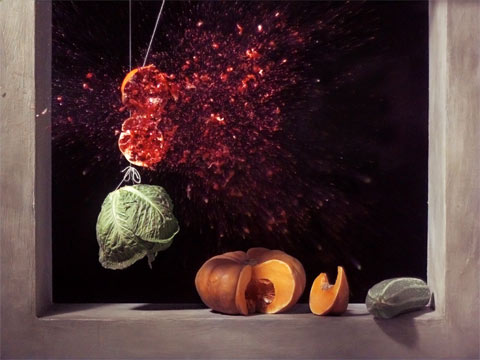
POMEGRANATE Gersht's evocations of war in include Old Master-like still-lifes being blown to bits. |
At the heart of Ori Gersht's art is a question: how to capture the ghosts of the Holocaust, Hiroshima, and Israel's wars? Gersht's work is about the persistence of trauma, the elusiveness of memory — "an attempt," he tells me, "to hold onto something that's already lost."
>> SLIDESHOW: ''Ori Gersht: History Repeating'' <<
In "History Repeating," a striking survey of 25 works since 1998 curated by Al Miner at the Museum of Fine Arts (465 Huntington Avenue, Boston, through January 6), the London-based artist's answer is a violent poetry. Hyper-detailed lush videos and photos show trees crashing down in a forest, a man falling apart as he crosses mountains, and — in the work for which he is best known — Old Master-style still-lifes blasted to bits.
Born in Tel Aviv in 1967, Gersht's first war was the Arab-Israeli Six-Day War when he was a baby. Childhood memories include his father, who ran an art-house cinema, called up for Army service; the sirens and bomb shelters of 1973's Yom Kippur War; his mother sheltering him with her body; officials visiting the neighborhood to announce soldiers' deaths. His grandmother spoke of leaving Poland for Israel in 1933 to avoid an arranged marriage, and about the family she left behind disappearing into the Nazi death machine. Gersht served in the Israeli Army as a medic in the '80s, where he was lucky enough to avoid crisis action, but constantly rehearsed treatment of traumatic wounds and chemical burns.
In 1988, he moved to London seeking anonymity, and attended art school. He found his subject by driving to Sarajevo in 1998, a few years after the seige there during the Bosnian War, and photographing the city's scars. Then a plane to Poland in 1999. Riding a train from Krakow to Auschwitz, he photographed passing buildings that seemingly remained as mute witnesses to Nazi murders.
But Gersht's reputation depends on videos. The Forest (2005) slowly pans across woods in silence until, suddenly, a tree smashes to the ground. One after another trees fall (Gersht arranged for regular forest pruning to be sped up). We don't see what is cutting them down. And once they fall (outside the frame), they leave no apparent wound in the canopy. The feeling is of disaster coming quickly, unexpectedly, inexorably.
In Pomegranate (2006), a bullet roars into an exquisite arrangement of fruits and vegetables that resembles an Old Master painting. It shatters a pomegranate (in Hebrew, the word also means "grenade") into a bloody red slow-motion shower. At first, the Hollywood polish is seductive, the gunshot jolting, but repeated viewings can make it feel absurd: let's blow up an Old Master!
The two-screen 15-minute projection Evaders (2009) alternates between sublime mountains into which a person appears and disappears like a ghost, and then close-ups of an older man, bleary eyed and drooling, as he staggers, exhausted, through darkness. It's marvelous and grueling. The climax is the man walking up a dark corridor into white light. Such a stock Hollywood metaphor for dying can jar you out of the film's reverie.